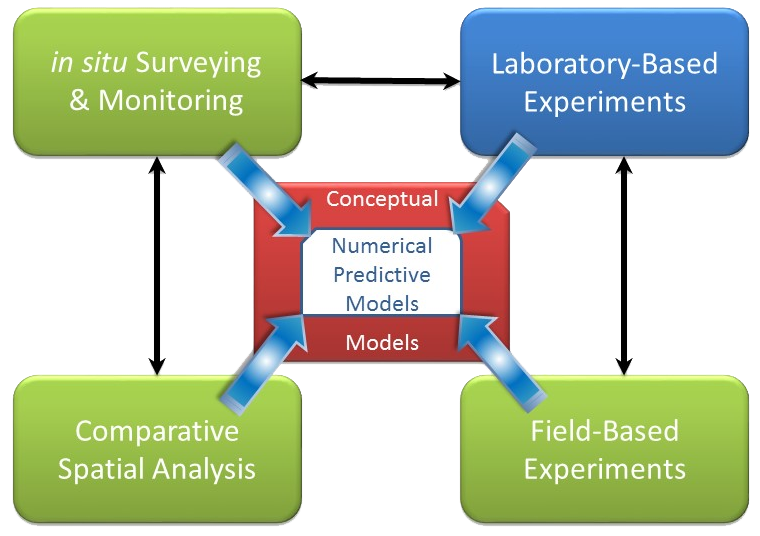C-IMAGE is working to advance understanding of the fundamental processes and mechanisms involved in marine blowouts and their environmental consequences, ensuring that society is better-prepared to mitigate such future events. Integration of field sampling, experimental designs and modeling will provide a comprehensive and Gulf-wide view on the short and longer term environmental impacts of oil spills.

The C-S-I Approach
Continue analyses, experiments, and modeling studies from C-IMAGE I & II
Synthesize findings of GoMRI, government agencies, and other entities
Integrate across field sampling, lab experiments and modeling developing a transformative understanding of oil spills
Near- & Far-field Modeling and High-pressure Experimentation

Synthesis Efforts
- Incorporate high pressure experimental findings with live oil, dispersants and degradation rates
- Develop MOSSFA and sedimentation models
- Continue generating 3-D fields of oil concentrations to assess ecological effects of DwH
- Simulate alternative deep spill scenarios and integrate ecosystem modeling outcomes
- Inject dispersant into live-oil experiments to simulate DwH response
- Develop Turbulent Kinetic Energy (TKE) model using a laboratory to field “scale-up” approach
- Perform critical experiments for future spills with varying blowout conditions, oil types and biodegradation capacity
Benefits
Simulating the conditions of the DwH blowout in high-pressure laboratories provides key input parameters to the models such as accurate droplet size distributions, rise velocities, and mass transfer in high-pressure, low-temperature environments.
A fully integrated oil spill transport model will give the response community abilities to select specific locations, potential dispersant use, and oceanographic conditions to accurately predict the distributions and consequences of a spill and subsequent response strategies.
Sediment, Microbial Degradation, and MOSSFA

Synthesis Efforts
- Complete analysis of sediment samples collected in 2017 (Δ
14C, δ13C, forams, macrofauna, 234Th) - Assess ecosystem impacts of MOSSFA using Deepwater Horizon and Ixtoc I as known instances
- Identify components for MOS formation and distribution
- Develop a dispersion model to simulate MOSSFA production
Benefits
C-IMAGE has established a Gulf-wide assessment of benthic recovery on annual and decadal scales. Understanding recoveries of past spills provides context for predicting recovery in future spills. These concepts can be incorporated into revised policies for oil spill response.
Ecosystem Impacts

Synthesis Efforts
- Complete HPLC and GC/MS analyses to derive Gulf-wide PAH maps
- Incorporate SIPPER plankton scans and satellite imagery to the modeling module
- Develop metrics for community resilience using biodiversity data
- Compare impacts of PAH exposure of fish from the natural environment and exposure studies
- Determine factors responsible for changes in marine mammal densities following oil spills
- Assess the resiliency of reef populations to multiple stressors through metagenomics studies
Benefits
The collection of OneGulf surveys provide material for Gulf wide maps of acute and chronic PAH exposure, depuration, and impacts in various trophic levels. The extensive library of field collections can help us estimate the population level connectivity in the Gulf to determine resilience capacity.
Toxicology Studies

Synthesis Efforts
- Compare biomarkers in fish from field specimens with those in exposure studies
- Spawn F1 generations of trial fish to identify sub-lethal effects across generations
- Expand individual immunotoxicity to adverse effects in larger population
Benefits
C-IMAGE III will expand our understanding of the lasting sublethal oil impacts on fisheries by testing potential heritability from oil exposures to fish.
Ecosystem Modeling

Synthesis Efforts
- Refine Atlantis model with MOSSFA impacts and integration/validation with far-field transport models
- Compare the Atlantis and Campeche Bay models for comparative studies
- Apply MOSSFA impacts to the Campeche Bay model
- Estimate plankton flux as a result of MOSSFA events
Benefits
Compiling and integrating results from GoMRI studies into ecosystem modeling efforts can provide assessments of cascading food web impacts and predict long term recovery. Further, adding a MOSSFA component to ecosystem models can help responders better identify potentially biologically sensitive areas.


